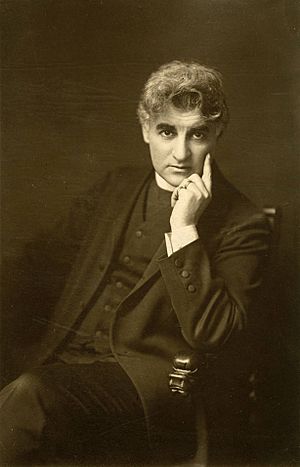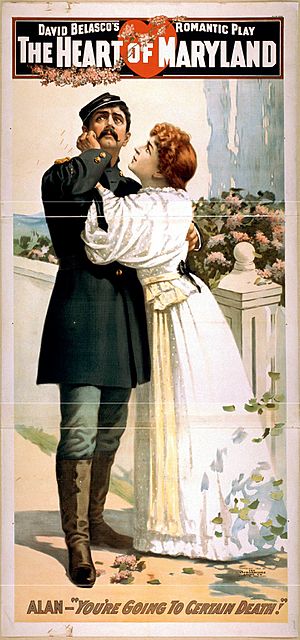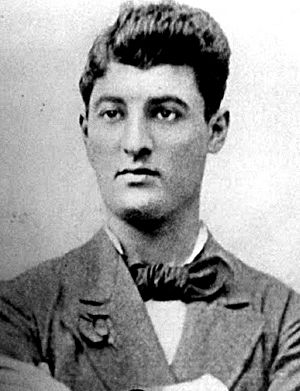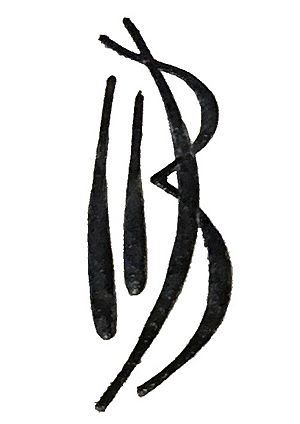David Belasco facts for kids
Quick facts for kids
David J. Belasco
|
|
|---|---|
 |
|
| Born | July 25, 1853 San Francisco, California, U.S.
|
| Died | May 14, 1931 (aged 77) New York City, U.S.
|
| Occupation | Theatrical producer, director, playwright |
| Years active | 1884 to 1930 |
| Known for | Belasco Theatre; pioneer of modern stage lighting and stage effects; stage naturalism |
|
Notable credit(s)
|
Madame Butterfly |
| Spouse(s) |
Cecilia Loverich
(m. 1873; |
| Signature | |
David Belasco (born July 25, 1853 – died May 14, 1931) was an important American theater producer, director, and playwright. He was the first person to turn the short story Madame Butterfly into a play. Belasco helped many actors start their careers, including Mary Pickford and Barbara Stanwyck. He was also a leader in using new stage lighting and special effects to make plays look more real.
Contents
Early Life and First Steps in Theater
David Belasco was born in 1853 in San Francisco, California. His parents, Abraham and Reyna Belasco, were Sephardic Jews. They had moved to the United States from London during the California Gold Rush.
As a young boy, David started working in a San Francisco theater. He did many different jobs, like being a call boy (who calls actors to the stage). He also copied scripts and played small parts as an extra. He learned how to be a stage manager while traveling with theater groups. He once said they performed "in any place we could hire... a hall, a big dining room, an empty barn."
Learning in Virginia City
From late 1873 to early 1874, Belasco worked at Piper's Opera House in Virginia City, Nevada. He acted, directed, and worked as a secretary there. He found the city to be full of "reckless women and desperadoes." His time there helped him imagine and create very realistic stage settings later on. He wrote about these experiences in Hearst's Magazine in 1914.
By March 1874, he was back in San Francisco. He eventually managed the Baldwin Theater for Thomas Maguire. When Maguire lost the theater in 1882, Belasco moved to the East Coast. He brought all his practical theater experience from the West with him. The West helped him become skilled in performing and in creating new ways to design and put on shows.
Moving to New York City
Belasco was a very talented playwright. He moved to New York City in 1882. He worked as a stage manager for the Madison Square Theatre and then the old Lyceum Theatre. At the same time, he also wrote his own plays. By 1895, he was so successful that many people thought he was America's most important playwright and producer.
A Busy Career in Theater
David Belasco had a very long and creative career, from 1884 to 1930. During this time, he wrote, directed, or produced more than 100 Broadway plays. Some of his famous plays include Hearts of Oak and The Heart of Maryland. He became one of the most powerful people in the New York City theater world.
Helping Stars Shine
Belasco helped many actors become famous stage performers. Many of them later worked in movies too.
- Leslie Carter was called "The American Sarah Bernhardt." She became a huge star after working with Belasco in plays like Zaza (1898).
- Ina Claire became famous after her lead roles in Polly with a Past (1917) and The Gold Diggers (1919).
- Belasco wrote a main part for 18-year-old Maude Adams in his play Men and Women (1890). This play ran for 200 performances.
- He also helped start the careers of Jeanne Eagels, Lenore Ulric, and David Warfield.
- Belasco discovered Barbara Stanwyck and even changed her name.
- Mary Pickford appeared in his plays The Warrens of Virginia and A Good Little Devil. Belasco is also credited with giving her stage name.
- He worked with Lionel Barrymore in the play Laugh, Clown, Laugh.
Famous Plays and Operas
Belasco is perhaps most famous for two of his plays that became very popular operas. He turned the short story Madame Butterfly into a play with the same name. He also wrote the play The Girl of the Golden West.
The famous Italian composer Giacomo Puccini turned both of these plays into operas:
- Madama Butterfly (1904)
- La fanciulla del West (1910)
More than forty motion pictures were also made from Belasco's many plays.
Working with Film Legends
Many important performers from the late 1800s and early 1900s wanted to work with Belasco. These included D. W. Griffith, Helen Hayes, Lillian Gish, Mary Pickford, and Cecil B. DeMille. DeMille's father was a close friend of Belasco. After film director DeMille finished school, he started his stage career with Belasco's help. DeMille later used Belasco's methods for directing actors, using dramatic lighting, and staging scenes in his films.
Family Life
David Belasco was married to Cecilia Loverich for more than fifty years. They had two daughters named Reina and Augusta. Reina later married a producer named Morris Gest.
Later Years and Passing
Belasco passed away in 1931 in Manhattan. He was 77 years old. He was buried in the Linden Hill Jewish Cemetery in Ridgewood, Queens.
Belasco's Impact on American Theater

Belasco wanted actors to perform in a natural way. To help with this, he created stage settings with very realistic lighting effects. His shows inspired many future theater lighting designers.
At first, people didn't appreciate Belasco's new stage and lighting ideas as much as those from Europe. But today, he is seen as "one of the first important directors in American theater history."
Pioneer of Modern Stage Lighting
Belasco brought a new level of realism to the American stage. He was the first to develop modern stage lighting. He used colored lights with motorized wheels to create different moods and settings. America's first stage lighting company, Kliegl Brothers, started by making special equipment for directors like Belasco.
One famous example of his lighting was in his play Girl of the Golden West (1905). The play opened with a spectacular sunset that lasted five minutes before any talking began!
Belasco was also one of the first directors to hide lights below the stage floor. This way, the audience couldn't see the lights themselves. His lighting assistant, Louis Hartmann, helped make Belasco's ideas happen. Belasco also used 'follow spots' to make things look even more real. He even had a special 1000-watt lamp made just for his shows. He was the only director to have one for the first two years after it came out (1914–1915).
In his own theaters, the dressing rooms had lamps with different colors. This allowed actors to see how their makeup looked under various lighting.
Detailed Sets and Realism
It was said that Belasco would even add smells to the theater's ventilation system to match the scenes. His sets were incredibly detailed and sometimes even extended into the audience area. For example, in one play, a working laundromat was built on stage. In The Governor's Lady, the stage had a copy of a Childs Restaurant kitchen. Actors actually cooked and prepared food during the play!
Belasco's original scripts often had long, specific descriptions of props and set decorations. He was known for creating very realistic scenes.
Belasco used existing theater technology and also tried to make it better. Both of his New York theaters were built with the newest technology of their time. When he took over the Republic Theatre, he dug a new basement for his machinery. The Stuyvesant Theatre was built especially for him with lots of space above the stage, hydraulic systems, and lighting equipment. The basement of the Stuyvesant had a working machine shop. Here, Belasco and his team experimented with lighting and other special effects. Many of the new ideas from Belasco's shop were sold to other producers.
The writer F. Scott Fitzgerald mentioned Belasco's reputation for realism in his novel The Great Gatsby (1925). A character in the book is amazed that the books in a library are real. He says, "This fella's a regular Belasco. It's a triumph. What thoroughness! What realism!"
Belasco's Theaters
New York City Theaters
The first Belasco Theatre in New York was on West 42nd Street in Times Square. Belasco took over this theater in 1902 and completely changed it. He stopped managing it in 1910, and it was renamed the Republic. It reopened as the New Victory Theater in 1995.
The second Belasco Theatre is on West 44th Street, a few blocks away. It was built in 1907 as the Stuyvesant Theatre and renamed after Belasco in 1910. This theater was built exactly how Belasco wanted it. It had Tiffany lighting, beautiful woodwork, and murals. Belasco's office and private apartment were also in this building. The Belasco Theatre is still used today for Broadway shows. Much of its original decoration is still there. In 2010, it had a big $14.5 million restoration to make it look like it did when David Belasco was alive.
Theaters in Other Cities
Belasco Theatres also existed in other cities. In Los Angeles, the first Belasco Theatre opened in 1904. It was managed by David Belasco's brother, Frederick. This theater was later renamed and eventually became a burlesque venue. It was torn down in 1974.
The second, and more famous, theater in Los Angeles is called The Belasco. It opened in 1926 and was managed by Edward Belasco, another of David's brothers. Many Hollywood and Broadway stars performed there. After Edward Belasco died in 1937, the theater declined. It closed in the early 1950s and was used as a church for many years. From 2010 to 2011, it was restored and is now used as a nightclub and event space.
The Shubert-Belasco Theatre in Washington, D.C., was bought by Belasco in 1905. It was originally built in 1895 as the Lafayette Square Opera House. This theater was torn down in 1962.
Selected Plays Written or Co-Written by Belasco
- Hearts of Oak (1879)
- La Belle Russe (1882)
- May Blossom (1884)
- Lord Chumley (1888)
- Men and Women (1890)
- The Girl I Left Behind Me (1893)
- Pawn Ticket No. 210 (1894)
- The Heart of Maryland (1895)
- Zaza (1898)
- Madame Butterfly (1900)
- Du Barry (1901)
- The Auctioneer (1901)
- Sweet Kitty Bellairs (1903)
- Adrea (1905)
- The Girl of the Golden West (1905)
- Rose of the Rancho (1906)
- The Return of Peter Grimm (1911)
- The Governor's Lady (1912)
- A Good Little Devil (1913)
- The Gold Diggers (1919)
- The Son-Daughter (1919)
- Kiki (1921)
- Laugh, Clown, Laugh (1923)
- Ladies of the Evening (1924)
- The Dove (1925)
- Lulu Belle (1926)
- Tonight or Never (1930)
Film Adaptations of Belasco's Works
Many of David Belasco's plays were turned into movies. Here are some of them:
- Lord Chumley (1914)
- Men and Women (1914)
- Rose of the Rancho (1914)
- The Girl of the Golden West (1915)
- The Heart of Maryland (1915)
- Madame Butterfly (1915)
- Zaza (1915)
- Sweet Kitty Bellairs (1916)
- The Heart of Maryland (1921)
- The Girl of the Golden West (1923)
- Zaza (1923)
- Tiger Rose (1923)
- Seven Chances (1925)
- Kiki (1926)
- The Return of Peter Grimm (1926)
- The Music Master (1927)
- Laugh, Clown, Laugh (1928)
- Ladies of Leisure (1930)
- The Girl of the Golden West (1930)
- Madame Butterfly (1932)
- The Girl of the Golden West (1938)
- Zaza (1939)
Films Produced by Belasco
David Belasco also produced several films:
- A Good Little Devil (1914)
- Rose of the Rancho (1914)
- The Girl of the Golden West (1915)
- The Warrens of Virginia (1915)
- The Governor's Lady (1915)
- The Gold Diggers (1923)
- Tiger Rose (1923)
Film About David Belasco
- Lady with Red Hair (1940), a movie where actor Claude Rains played David Belasco.
See also
 In Spanish: David Belasco para niños
In Spanish: David Belasco para niños
- The Auctioneer (1927)
- William Ziegler House



